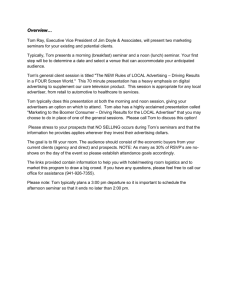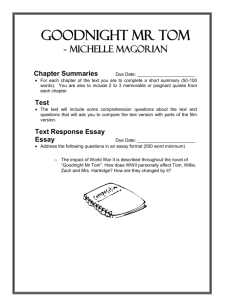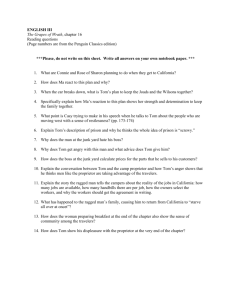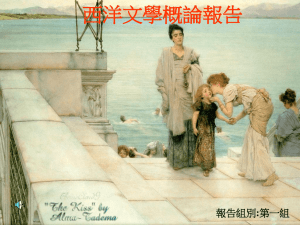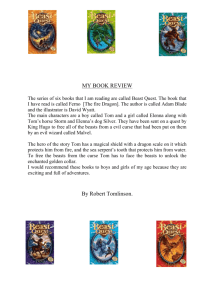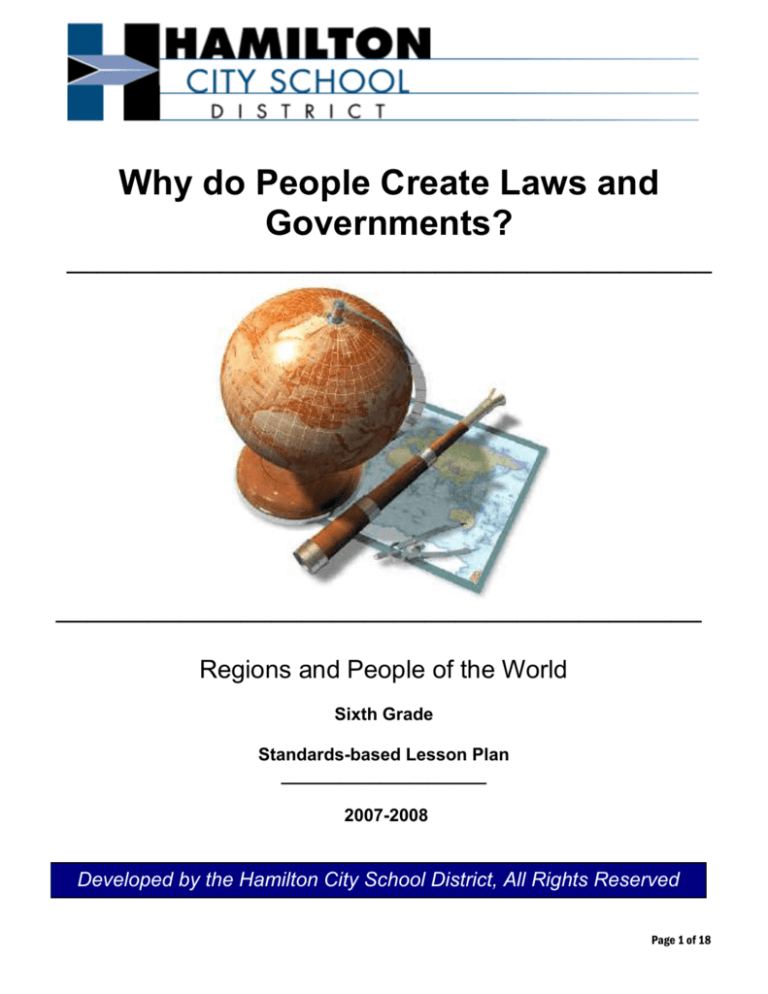
Why do People Create Laws and
Governments?
__________________________________________
__________________________________________
Regions and People of the World
Sixth Grade
Standards-based Lesson Plan
_____________________
2007-2008
Developed by the Hamilton City School District, All Rights Reserved
Page 1 of 18
Lesson Summary / Overview
Title: Why do People Create Laws and Governments?
Duration: 2-3 Days / Class Periods
Targeted Benchmarks and Indicators
Social
Studies
Skills and
Methods
Government
Standard
Benchmark
Indicator
Gv6A. Explain why people institute
governments, how they influence
governments, and how governments
interact with each other.
Gv6A1. Explain reasons for the creation of
governments such as:
a. Protecting lives, liberty and property;
b. Providing services that individuals cannot
provide for themselves.
S6C. Present a position and support
it with evidence and citation of
sources.
S6C6. Communicate a position on a topic orally or
in writing and support the position with evidence.
Final Assessment:
Students will complete a traditional test to culminate work on the benchmarks and
indicators. Questions are written in OAT style –Multiple Choice, Short Answer, and
Extended Response.
Essential Questions – Focus Questions:
1.
2.
3.
4.
What would life be like, if there were no government?
Why do people create governments and laws?
What are the major functions of government?
What is the most important function of government?
Key Vocabulary
Government
Institute
Influences
Interact
Public Services
Support
Evidence
Functions of Government
Social Order
Preview Activity (Pre-Assessment or “Before” Activity):
Ask the students to respond in a focused free-write to the following prompt: What would
life be like without laws or governments? After 3-5 minutes, conduct a classroom
discussion and ask the students for one descriptor they included in there writing. List the
descriptions on the board or overhead. Then ask the students to whether they thought
that have no government or set of laws was a good thing. Then transition into the “Day in
the Life of Tom Phillips activity to explore the various ways that the government touches
our lives each day.
Page 2 of 18
Engaging Activity 1 – How the Law Affects You: A Day in the Life of Tom Phillips
Instructions: During this activity students will read the story, "A Day in the Life of
Tom Phillips." Then re-read it, and underline each word in the story that involves a law.
The purpose is for them to discover the many ways that government directly and
indirectly affects their lives everyday. A quick review of several government department
agencies and local government services may help build some background knowledge for
the students (see http://www.usa.gov/Agencies/Federal/Executive.shtml for a listing at the
national level)
Engaging Activity 2 – Creating Major Functions of Governments Organizational
Chart
After the students have explored how the government impacts their lives everyday, send
them on a mission to organize and describe the basic functions of governments on a
provided organizational chart. Students will also rank the major functions of government
(ranking 1-6) and identify 2 examples for each. The wrap-up the activity students will
answer the following question: What is the most important function of Government and
Why?
Authors notes:
Page 3 of 18
Background Reading for Teachers:
Page 4 of 18
Page 5 of 18
Page 6 of 18
Page 7 of 18
Final Assessment
1. Which is the best definition of a government?
A. A collection of laws used by judges to interpret situations and settle disputes.
B. A political system or structure for exercising authority over people in a particular
geographic area.
C. The actions of a group of people to protect their neighbors for harm and
discrimination.
D. The collective effort by the people from different nations to protect basic human
rights.
2. People create governments to
A.
B.
C.
D.
provide private goods and services to individual people of companies.
protect lives, liberty, and property.
maintain a minimum standard of living or lifestyle.
guarantee people the right to healthcare and a good job.
3. Why do governments provide public goods and services for their citizens?
A. It is not profitable or possible for individuals or businesses to provide public goods
and services for citizens.
B. Governments do a better job of managing their money then individuals and
businesses.
C. The market system provides all the goods and services that people need; the
government fulfills their wants.
D. Countries with market economies tax and provide public services to ensure that all
household incomes are equal among its citizens.
4. Today, most developed nations settle disputes through
A.
B.
C.
D.
military force
their court systems.
police action
the law making process.
5. Maintaining Social Order within a nation and local community is primarily the
job of the
A.
B.
C.
D.
State Representatives
Police Departments
Local City Council
Supreme Court
Page 8 of 18
6. Most modern counties have a written constitution that outlines the structure
and function of their nation’s government. In the United States Constitution, the
functions of government are introduced in the preamble or opening paragraph
of the document.
One of the functions stated in the preamble to the U.S. Constitution is to
“provide for the common defense.”
Which part of the national government is directly responsible for protecting
citizens from foreign attacks or invasion?
A.
B.
C.
D.
the U.S. Military
the Securities and Exchange Commission
the U.S. Congress
the Washington, D.C. police department
7. Identify two reasons why people establish governments. (2 points)
Page 9 of 18
ddd
Page 10 of 18
Final Assessment Key with Exemplar Answers
1. Which is the best definition of a government?
A. A collection of laws used by judges to interpret situations and settle disputes.
B. A political system or structure for exercising authority over people in a particular
geographic area.
C. The actions of a group of people to protect their neighbors for harm and
discrimination.
D. The collective effort by the people from different nations to protect basic human
rights.
2. People create governments to
A. provide private goods and services to individual people of companies.
B. protect lives, liberty, and property.
C. maintain a minimum standard of living or lifestyle.
D. guarantee people the right to healthcare and a good job.
3. Why do governments provide public goods and services for their citizens?
A. It is not profitable or possible for individuals or businesses to provide public goods
and services for citizens.
B. Governments do a better job of managing their money then individuals and
businesses.
C. The market system provides all the goods and services that people need; the
government fulfills their wants.
D. Countries with market economies tax and provide public services to ensure that all
household incomes are equal among its citizens.
4. Today, most developed nations settle disputes through
A. military force
B. their court systems.
C. police action
D. the law making process.
5. Maintaining Social Order within a nation and local community is primarily the
job of the
A. State Representatives
B. Police Departments
C. Local City Council
D. Supreme Court
Page 11 of 18
6. Most modern counties have a written constitution that outlines the structure
and function of their nation’s government. In the United States Constitution, the
functions of government are introduced in the preamble or opening paragraph
of the document.
One of the functions stated in the preamble to the U.S. Constitution is to
“provide for the common defense.”
Which part of the national government is directly responsible for protecting
citizens from foreign attacks or invasion?
A.
B.
C.
D.
the U.S. Military
the Securities and Exchange Commission
the U.S. Congress
the Washington, D.C. police department
7. Identify two reasons why people establish governments.
Possible Answers:
1. Protecting Lives, liberty, and/or Property (Basic Human Rights)
2. Maintaining Social Order or keeping peace
3. Settling Disagreements
4. Protecting the nation from outside attacks or “providing for the common defense”
5. Providing Public Services (services individuals can’t provide themselves)
6. Facilitating and Regulating Economic Activity
Scoring Rubric
Points
Student Response
2
Student accurately identifies 2 reasons people establish or create
governments
1
Student accurately identifies 1 reason people establish or create
governments
0
Student did not accurately identify any reasons people establish or create
governments
Page 12 of 18
Preview Activity - Life without Laws or Government
Focused Free-write – In the next 3-5 minutes, respond to the following prompt:
What would life be like without laws or governments?
Page 13 of 18
Engaging Activity 1- How the Law Affects You
Now that we have explored what life would be like with out laws and the reasons that we
have laws, let’s look at how the government protects us and provides public goods and
services. Read the story, "A Day in the Life of Tom Phillips." Then re-read it and
underline each word in the story that involves a law or the Government. Explain how each
daily activity is connected to a law, document, or agency on the chart that follows the
story. For Example, begin by underlining "Tom Phillips." Your name is your identity in
society. It's given to you at birth, recorded on a birth certificate, and used on the all legal
documents throughout your life. If you don't like your name, you can change it through a
legal procedure through the court system.
_____________________________________________________________________________________
"A Day in the Life of Tom Phillips"
Tom Phillips is twelve years old. He lives at 2893 Pleasant Avenue in Hamilton, Ohio
with his family, a mother and father, a brother, and a dog. Today was a school day, so Tom got
up when his mother called home from work at 7:00 a.m. He washed his face with Dial soap,
brushed his teeth with Crest toothpaste, and then got dressed for school.
Soon Tom came to the kitchen. He turned on the television and sat down to eat a
breakfast of orange juice, a bowl of Cheerios, toast, and quart of milk. When he finished eating,
Tom attached a leash to his dog's collar and took the dog for a walk around the block.
Returning to his house, Tom heard the sound of the school bus. He grabbed his books
and ran to meet the bus, which had stopped in front of his house with its red lights flashing. Tom
boarded the bus and greeted the bus driver with a friendly smile. Another day of school was
about to begin.
Page 14 of 18
Engaging Activity 1- How the Law Affects You
Daily Activity
Government Connection
Page 15 of 18
Engaging Activity 2 - Major Functions of Government Organizational Chart
We have now looked at what life would be like without governments and how the
government is a part of our daily life. Now it is time to describe and rank the 6 major
functions or purposes of government using the graphic organizer below. Please provide
2 examples of how governments perform each function. To wrap-up this assignment,
explain why you selected a particular function of government as the most important on
the following page.
Ranking Function of
Government
Protecting
Lives, liberty,
and Property
Description
Examples
Providing
Public
Services
Settling
Disagreements
Maintaining
Social Order
Protecting the
nation from
outside attacks
Facilitating and
Regulating
Economic
Activity
Page 16 of 18
Engaging Activity 2 - Major Functions of Government Organizational Chart
What is the most important function of Government? Why?
Page 17 of 18
Connections
Differentiated Instructional Support (Scaffolds)
To help struggling, special education, or ESL students, the teachers can limit the number of
items that students need to identify and explain.
The same strategy can be applied to the 2nd engaging activity as well. Students should be
familiar with all the function, but the number of examples can be limited.
Extensions (Gifted)
To extend Engaging Activity 1, the teacher can ask the students to write a short essay on a
typical day in their lives (skipping lines) and then follow instructions for the rest of the activity.
To extend the Engaging Activity 2, the teacher can ask students to create a Flip Book that
visually provides examples for each function of government. The pages should be organized
according to the rank that the students give them.
Homework Options and Home Connections
Any of the activities can be given as homework, which leaves final determination of when and
how these exercises up to the classroom teacher.
Interdisciplinary Connections
Use the Four Square Writing Approach to answer extended response items with supports and details.
Technology Connections
This lesson could easily be adapted into a power point slide show or used with a smart board.
Educational Research Connections and other Sources
Marzano, R. et al. Classroom Instruction that Works: Research-based Strategies for Increasing
Student Achievement, Alexandria, VA: Association for Supervision and Curriculum Development,
2001.
David T. Naylor. “Ohio Law and Government in Action: A Content Manual for Teachers with
Classroom Applications.” (1994). pp. 5-8.
David T. Naylor. "Law Studies in the Schools: A Compendium of Instructional Strategies."
Social Education, Vol. 41 (March, 1977) pp. 170-171. Reprinted with the Permission of the
National Council for the Social Studies.
* “A Day in the Life of Tom Phillips” is based on a lesson written by David T. Naylor, which was
originally published in the NCSS publication, Social Education.
Page 18 of 18




